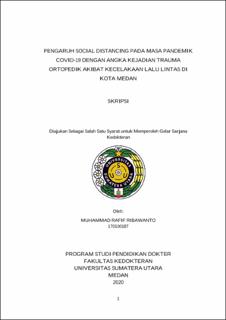| dc.description.abstract | Introduction. One of the highest morbidities from vehicular accidents is orthopaedic trauma. The COVID-19 pandemic is one of the biggest historical events that happened so far in 2020. One of the acts that has been enacted by various governmental instances is the social distancing rule to the general public, where the number of present vehicles that are on the road is expected to go down. Aim. This study aims to determine the effect of social distancing during the COVID-19 pandemic on the number of orthopaedic trauma patients due to vehicular accidents in Medan. Methods. This study is an observational analytical study with a cross-sectional design. Secondary data was obtained in the form of orthopaedic trauma patients’s medical record from RSUP Haji Adam Malik from 2019-2020 and analyzed using the Independent Sample T-Test. Results. The number of orthopaedic trauma patients due to vehicular accidents dropped down from 505 patients before the social distancing period to 211 patients during the social distancing period, which signified a 41,79% decrease. Out of 211 orthopaedic trauma patients due to vehicular accidents, 150 were diagnosed with fractures (71,1%), 34 wound lacerations (16,1%), 15 dislocations (7,1%), 10 muscle rupture (4,7%), and 2 sprains (0,9%). Conclusion. There is a significant difference between the number of orthopaedic trauma patients due to vehicular accidents before the social distancing period and after the social distancing period, and the decrease in the number of patients can be used as a guide to determine that the social distancing enactment in Medan has succeeded.
Keywords: COVID-19, Social Distancing, Orthopaedic Trauma, Vehicular Accidents | en_US |


